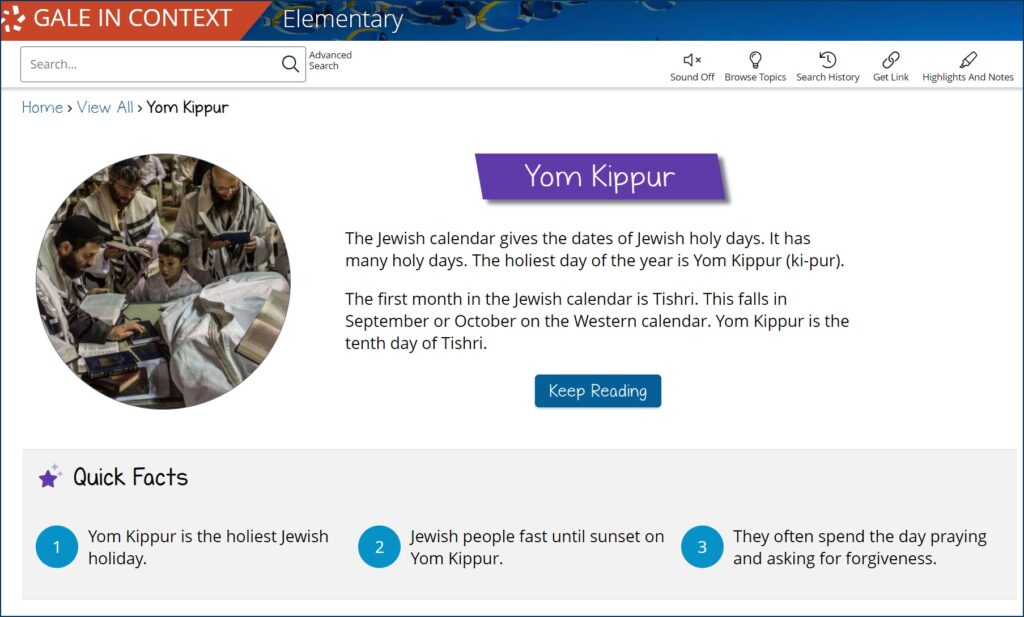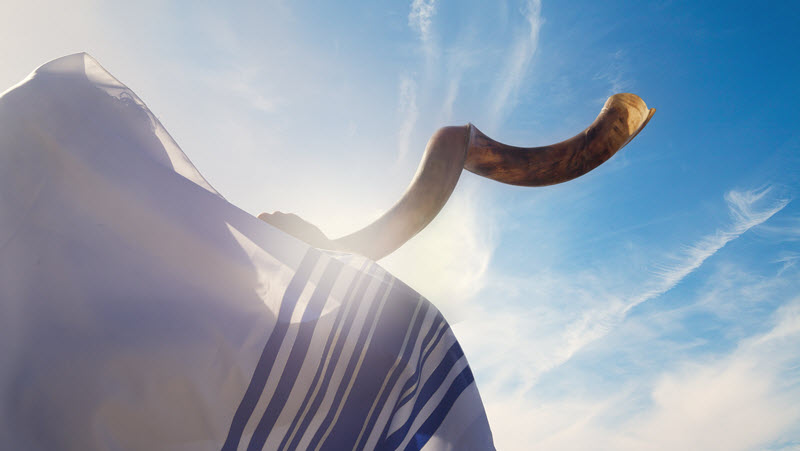| By Gale Staff |
Yom Kippur is an annual Jewish holy day centered around atonement and forgiveness. Those who practice Judaism spend the day reflecting on past mistakes and making amends. Typically, observers fast for 24 hours and attend a religious service.
Unlike the standard Gregorian calendar, the Hebrew calendar follows the lunar cycles, which divide the year into 12 unique months. Yom Kippur occurs 10 days after Rosh Hashanah, the Jewish New Year, during the month of Tishrei. The period between the two major holidays is known as the 10 Days of Awe, a period of contemplation when observers make peace with others and prepare for God’s judgment on Yom Kippur.
In recent months, Jewish people have increasingly been targeted by acts of prejudice and violence. During these times of elevated antisemitism in the United States, it seems especially pertinent to integrate positive and culturally sensitive activities about the Jewish faith into our elementary classrooms. This fall, Yom Kippur begins on Friday, October 11, presenting a valuable opportunity to do just that.
To start developing your lesson plan, Gale In Context: Elementary has a portal dedicated to Yom Kippur. Educators can find kid-friendly articles, magazines, and images within this database to boost students’ curiosity about this unique holiday and expand their understanding of the Jewish faith. While young learners discover the foods, traditions, and history of Yom Kippur, encourage them to find similarities in their own family’s cultural customs. For students who practice Judaism, welcome their insights and personal stories about Yom Kippur. Introducing children to different holidays helps them develop an interest in other cultures and a more global perspective.

Understand the History of the Jewish Faith
To really understand a religion or culture’s beliefs, it’s essential to study its history and associated legends. Judaism is more than 3,000 years old, predating and heavily influencing Islam and Christianity. It is one of the first monotheistic faiths, and its followers learned their religious teachings through prophets sent by God. One such prophet was Moses, whose life is documented throughout the Torah. These stories share a significant overlap with the Old Testament, which might already be familiar to some of your students.
According to the Jewish faith, after leading the Israelites from Egypt, Moses climbed Mount Sinai, where God gave him the Ten Commandments, outlining the foundation of the Jewish moral code. Millennia later, these teachings continue to guide modern-day religious and cultural practice.
Discussion Idea: Today, there are more than 15 million Jewish people in the world. Because of an extensive history of prejudice and persecution, the vast majority live in either the United States or Israel. With your class, introduce the concept of prejudice and explore how misinformation and stereotypes can be dangerous.
Share the Story of Yom Kippur
According to the story, when Moses first descended Mount Sinai with the Ten Commandments, he discovered his followers worshipping a false idol: a golden calf. Angered, Moses destroyed the tablets on which the Ten Commandments were written, and God spread a plague upon the people. After a period of reflection and penance for himself and his followers, Moses climbed Mount Sinai once again for another set of tablets and God’s forgiveness.
This moment marks the first observation of Yom Kippur. Today, in remembrance of those origins, Jewish people spend the holiday at synagogue and reflect on their mistakes from the previous year. These themes of fasting, prayer, and reflection transcend most major religions, including Christians’ observance of the 40 days of Lent and Muslims’ fasting during Ramadan.
Activity Idea: With Gale In Context: Elementary, your students can learn the history, vocabulary, and general themes of Yom Kippur. One major lesson is that of positive change—how can we learn from our past mistakes? Using this helpful outline, students can make their own shofar (a special horn used for holy days). They can write down past mistakes on slips of paper and tuck them into their horn, committing to do better in the future.
Discover How Jewish Families Celebrate Yom Kippur
Of course, Yom Kippur customs can vary, but most Jewish families share certain symbols and traditions. Yom Kippur celebrations begin the night before the official holiday, during which observers light candles in memory of loved ones who have passed away. Family members don festive outfits and gather for a robust meal before sunset. The pre-fasting meal often consists of challah dipped in honey, hearty soups, and sometimes kreplach (triangular dumplings filled with ground meat). From sunset through the following day, adults avoid eating and spend the day at their synagogue. Children do not typically fast but will instead forego extra indulgences, such as their favorite snacks.
Depending on the community, Jewish people may or may not wear traditional garb to the synagogue. However, for Yom Kippur, it’s a long-held tradition to avoid wearing leather, which is considered a symbol of luxury. Instead, despite their more formal outfits, many attendees wear canvas sneakers, Crocs, or even flip-flops to demonstrate their humility. Following service, families break their fast once the sun sets with indulgent foods like matzo ball soup, bagels, lox, blintzes, and cheeses.
Discussion Idea: Encourage your students to spend time researching the articles within Gale In Context: Elementary’s Yom Kippur portal. What customs feel familiar? Can they find similarities between Yom Kippur traditions and the holidays they celebrate at home? After all, regardless of religious or cultural background, many holidays feature large family meals, ritual components such as prayer or structured holy services, and special attire. By making connections between themselves and those from different backgrounds, young students begin to understand how our similarities transcend the things that divide us.
With Gale In Context: Elementary, students can have fun learning about Yom Kippur and other unique holidays from around the world. There are dozens of activities and topics to share. You might bring challah bread and honey for students to try or feature a fun Yom Kippur vocabulary word search. Holiday-themed lesson plans are a great way to introduce different cultures and foster a more accepting and global perspective.
If your school district is not a current Gale subscriber, contact a local representative to learn more and request a product trial.

